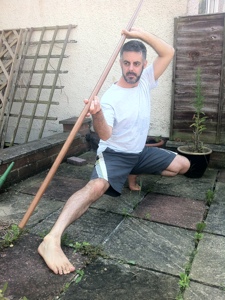When you train on your own on a daily basis it can be difficult to remain perfectly motivated. One way to get around this is by varying your training – change kata, combine your kihon in new ways etc.
My favourite way of mixing things up is through the practise of traditional ( and sometimes not so traditional) weaponry.
Historically, karate wasn’t really “empty handed”. Most of the great pioneers of karate were proficient in the use of weapons. Some of these old kata still bear their names – such as Sakugawa no Kon.
It is therefore no surprise that we also find many of the Shotokan masters are/were also skilled in weapons – Kanazawa, Asai, Stan Schmidt and even Gichin Funakoshi himself!
Aside from adding variety to your training, weapons help you to develop focused strikes and blocks as the weight of the weapon forces you to accelerate your limbs from the centre.
Each weapon helps you develop specific ways of moving:
• The nunchuku will help build range of motion of the shoulder and a driving hip rotation. In turn this develops large scale movement.
• The bo,surprisingly for a weapon of its size, develops compact, efficient movement, over large movement in fact hinders the bo. You’ll also help build grip strength if using a heavy bo.
• The sai are great for developing wrist and grip dexterity. Its actions most closely mimic that of the empty hand – therefore they have a very direct impact on punching and blocking technique.
Regardless of weapon, you’ll also get the chance to explore stances and footwork not normally found or infrequently practised in Shotokan.
Below is a defensive technique from Sakugawa no Kon.

